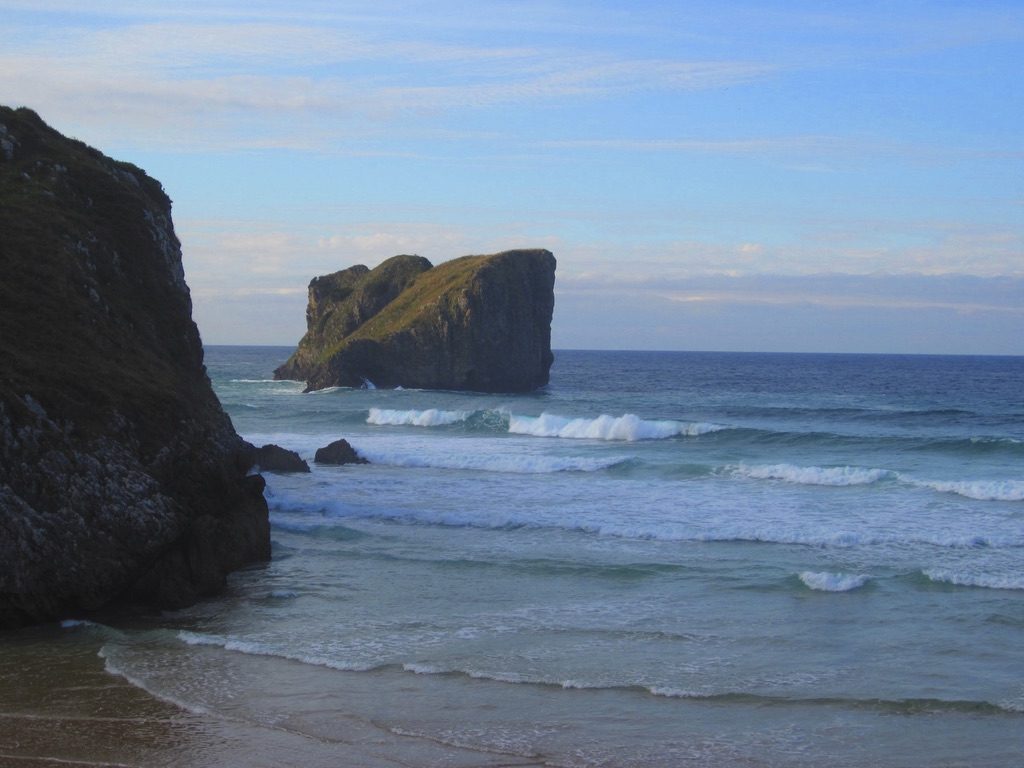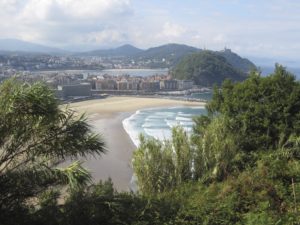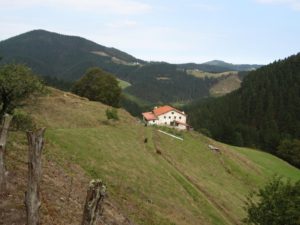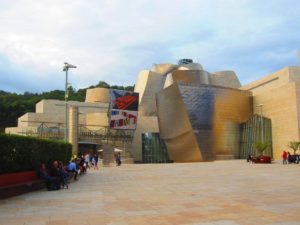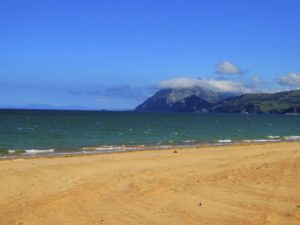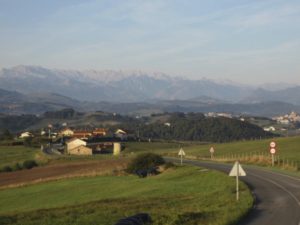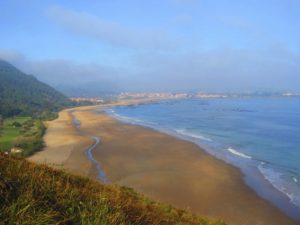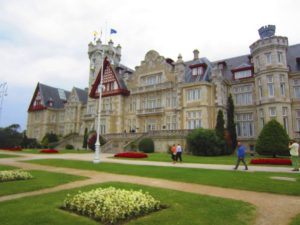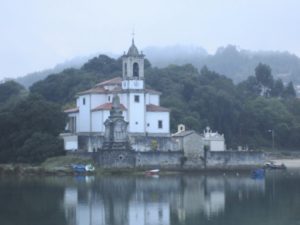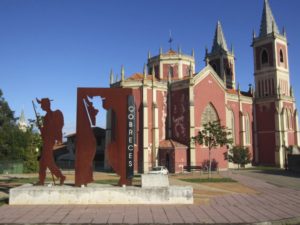CAMINO DEL NORTE
A WALK IN THE MOUNTAINS,
A STROLL ON THE BEACH
Beauty is normally in the eye of the beholder, but there can be little dispute that the Camino del Norte offers one of the most alluring walks on the planet. Running in parallel with its more famous and popular Camino cousin to the south, the Norte covers a similar 800 kilometre stretch but does so without the same crowds who trek the Frances. Although a tougher walk due to its frequent undulations, what it demands in physical endurance it more than compensates with its sumptuous array of ocean views, magnificent mountain panoramas, intriguing villages, and exciting metropolises. Those seeking to avoid the multitudes doing the Francés will find the Norte a delightful alternative. The route is well marked, and while there’s a good choice of albergues, many of them only open in the summer months so you might need to book your accommodation in advance.
The normal starting point for the Norte is Irun, a border town on the Spanish side of the Pyrenees. The path leads on through the lands of the Basque country which flow like a rollercoaster between mountains, meadows and beaches, stopping off in Spain’s gastronomic capital San Sebastian, the tragic focal point of Spain’s civil war in Guernica, and the trendy post industrial city of Bilbao. The landscape’s frequent rises and falls offer a challenge to the willing pilgrim, but this unique corner of Spain is filled with a richness and charm that makes the journey worthwhile.
The Norte passes from the Basque Country into the region of Cantabria, a windswept land of rugged hillsides and expansive beaches. The path veers from the coast inland and back again, passing through a series of intriguing towns and villages along the way. The region’s capital, the attractive city of Santander, is considered to be one of Spain’s best kept secrets, while the historic villages of Santillana del Mar, and Comillas, which is replete with a Gaudi house and other modernist curios, are destinations not to be missed. The atmospheric albergue at Guemes, with its famed hospitalero Father Ernesto, is one of the great experiences of this path.
The ancient Kingdom of Asturias is one of the least accessible regions of mainland Spain, and is a million miles removed from the conventional tourist trail, but it is a place of immense scenic beauty, golden beaches, and, should you choose to go there, home to the impressive city of Oviedo. Your initial walk will be bracketed between the towering Picos de Europa on one side, and the wild Atlantic way on your other. In the town of Villaviciosa pilgrims are faced with a choice whether to continue their journey to Santiago along the coast, or venture inland through the mountains via a route called the Primitivo. Whichever path you take, your days in Asturias will rank with the finest on any camino.
I followed the Primitivo, and I offer more detailed information about it here. Both the Norte proper and the Primitivo join up with the Francés in Galicia for the last 40 and 50 KM respectively. For those accustomed to the quiet splendor of the Northern routes this can come as a culture shock, but you’ll have a new circle of fellow travelers to keep you company on the final journey to Santiago. The Norte and its splinter routes are a well kept secret that are still enjoyed only by the more intrepid adventurers. While they don’t always have they quite same levels of collegiality, spirituality or facilities as the Francés, a journey along these paths allows you to immerse yourself in a land of epic beauty, rich history, sumptuous food, all of which allow for an unforgettable camino experience.
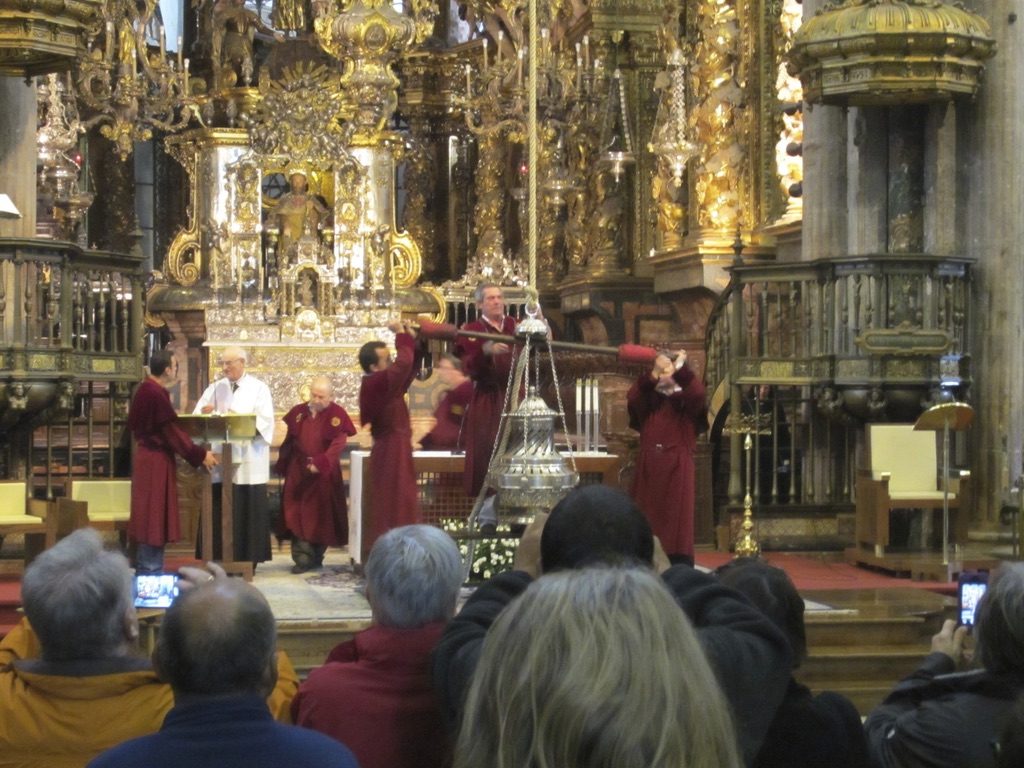
THE STAGES
I walked the Norte-Primitivo routes in September and October of 2016. With the exception of a few days the weather was beautiful, although I was told that 2016 was an especially good year, so perhaps the Camino Gods smiled on me. There were usually enough albergues to choose from, and they were well spread out so you won’t have to cover very long distances if you don’t want to. Some of them are seasonal, so if you’re not walking in the summer months when they’re open you should probably try and book ahead in popular places like San Sebastian, Zarautz, Bilbao and Santander. The usual equipment is required for these routes, and I’d highly recommend good walking sticks given the number of hills you’ll encounter. The following is a brief summary of the places in which I stayed on my journey. I’ve only included information up to Villaviciosa. From there I followed the Primitivo to Santiago, and you can find information about that on my Primitivo page. Buen Camino, and please contact me if you have any questions or comments.
Few walks begin more beautifully than this. Once you leave Irún you quickly find yourself in the countryside, and following a challenging uphill forest path. After a while it plateaus, and the stroll offers spectacular views of the surrounding landscape. A sharp decline to the village of Pasajes de San Juan ensues, where pilgrims are required to take a very short boat journey to the other side of the port. There’s another uphill climb afterwards, and the final descent of the day brings you right down to the beach in San Sebastian. Stroll along the promenade of the first beach, and then the Concha beach, perhaps the most impressive city beach in Europe, to the private albergue nearby. Best to book ahead for this one, as demand is high throughout the year.
The exit from San Sebastian is a pleasant route out of the city. Fairly soon you’ll find yourself on a country road with more impressive sea views. Today’s walk veers between woodlands and meadows, while the town of Orio about 10 KM into the walk is a good stopping point for refreshments. The charming seaside town of Zarautz, whose beach is a haven for surfers, is a very suitable stopping point for the night. The municipal albergue is open between July and August only, while the private hostel is open all year round. Again, best to book ahead in this town.
Another beautiful day’s walking, although the climbs and descents do provide some physical challenges. The town of Getaria, about 6 KM Zarautz, could be an alternative stopping point for those who wished to go a little further on the previous day. The town of Zumaia further up ahead is another inviting town worth exploring, while the mountainous meadows and lush woodlands that follow are a beautiful backdrop to today’s route. A very sharp decline leads down to the seaside town of Deba, which has a sizeable and comfortable municipal albergue in an old station house.
After leaving Deba there are a few impressive views of the sea, but from there the route heads inland into forested lands that seem alpine. A challenging day with many ascents and descents, the final destination for most is the town of Markina-Xemein, which has a municipal albergue in a convent. Those who want a little more could go a further 8 KM to the Monasterio de Zenarruza, where the monks have a small albergue and offer meals as well.
No seaside walks today, but it is still a very beautiful walk through forests, meadows and pleasant little Basque villages. The town of Gernika, famous for being bombed by the Germans in 1937 during the Spanish civil war and Picasso’s subsequently painting of the massacre, is today’s resting point. The town was rebuilt in more modern styles following its destruction, but it is still a place of great interest, and it has plenty of places to buy supplies. The youth hostel is probably the best place to stay for the night.
Many people choose to stop in Lezama after about 22 KM, and then have a short walk into Bilbao the following day. Those who have more energy will do it all in one go. There’s a good bit of road walking on the section leading into Bilbao, but final stretch of the path leads back into the countryside and offers great hillside views of the city. Bilbao is a big, bustling metropolis, most famous for Guggenheim Museum, but the city’s old town, cathedral and many shops and restaurants are well worth exploring too. Tired pilgrims might like to spend an extra night here to sample more of the city’s charms.
There are many routes out of Bilbao. I seemed to choose one that lead me on a circuitous path into the hills to the south of the city before depositing me back in the western suburbs. From there it’s a long slog through an industrial zone and near a motorway, but the last section along a quiet paved pathway is more pleasant. The attractive beach village of Pobena, with its pleasant albergue, is a very relaxing place to spend the night.
Today we leave the Basque Country and pass into the region of Cantabria. The landscape becomes more rocky and rugged, and we also return to the sea for long stretches. The town of Castro Urdiales is the main resting place for many, but the quieter village of Islares, a further 7.5 KM away, is a nice alternative.
Today’s walk begins and ends by the beach, but the path spends the rest of the day walking through the mesmorising variegated farmlands of Cantabria. The town of Laredo, with its sweeping sandy beach, is an attractive conclusion to the day’s walk. Laredo’s old town has an albergue in the convent, where both the nuns and the pilgrims bring food for the evening meal.
A long walk today, but a very beautiful one offering much variety. Walking along Laredo’s beach front in the early morning mist is one of the joy’s of this Camino. A short ferry ride is required to get to the town of Santona at the other side of the bay. Some choose to stay here instead of Laredo, and this town also has much to offer. Further down the road a very steep rise and dangerous descent provides the day’s biggest challenges, but the subsequent walk along the beach is the reward for the exertion. The path wanders inland through peaceful meadows and cornfields, and finishes in the famous albergue at Guemes, where the proprietor, Father Ernesto, provides wonderful hospitality while sharing his fascinating life story.
Another beautiful walk across clifftops and along glorious sandy beaches. At the village of Somo you’ll need to catch a ferry which will bring you straight to downtown Santander. This small city has much to recommend it, and for those with time on their hands it might be worth lingering here for an extra day. The 13th Century cathedral is an essential stop, while a stroll to the Palacio de la Magdelena at the the northern tip of of the city offers a beautiful seaside walk and offers a glimpse of the Santander’s rich and elegant architectural heritage.
Today is perhaps among the least interesting of the day’s on the Norte, with a lot of road walking, several drab stretches of industrial land, and none of the coastal charms that have been so abundant for the last few weeks. For the daring it even requires a short walk along a railway track, although more cautious pilgrims will actually take the train at this point. The end of today’s journey is the charming medieval village of Santillana del Mar, a popular tourist destination which offers plenty of accommodation and places to eat.
A nicer walk than yesterday’s, with some pleasant stretches through the rich Cantabrian countryside. The town of Cobreces has a number of interesting churches worth visiting, while today’s destination, Comillas, is one of the jewels of the Norte. This coastal town was a popular retreat for Barcelona’s aristocrats in the 19th century, and they employed the services of Antonio Gaudi among others to design some of the town’s magnificent modernist buildings.
Today we leave Cantabria and enter the kingdom of Asturias, which takes about 11 or 12 days to cross. The epic Picos de Europa come into view today, and will be a constant for the next few days. Nice coastal walks interchange with some more rural pathways, before a tough uphill slog to the pleasant town of Colombres. The Indianos architecture on display here, built with fortunes made in Latin America, is of particular note.
Another beautiful walk between the mountains and the sea. Many people gravitate towards the bustling and attractive town of Llanes, but for pilgrims who have a little more energy left in the tank, just a little less than 3 KM beyond Llanes is Playa de Poo, considered by many to be one of the best beaches in Spain. There’s a nice private albergue here in the shadow of the Picos de Europa, and the nearby beach is a perfect place for an afternoon dip or stroll.
This walk passes through the lush countryside of Asturias, much of it along rural pathways and forrest trails. It’s a quiet walk, with a scattering of small villages along the way. The destination for the day is Ribadesella, a pleasant seaside town with a good beach which is popular with surfers. The private albergue overlooks the beach, and the nearby Tito Bustillo Caves are town’s most important attraction.
This is a long walk, and is the last stage of the Norte for those who are planning to walk the remaining portion of the journey to Santiago via the Camino Primitivo. Some pleasant seaside walking in the earlier part of the day before the route heads inland. The town of Colunga is a best place to buy provisions or stay the night if you don’t want to go the whole distance. The remainder of today’s journey goes through Asturias’ rich agricultural lands, before stopping in the town of Villaviciosa, which is famous for being the apple capital of Spain.
Just beyond Villaviciosa the route splits in two. To continue with the Norte take the route to Gijon, while those wishing to do the Primitivo should follow the path to Oviedo. There is a strong uphill ascent at the beginning of the journey to Oviedo, and be sure to check out the oratory of San Salvador on this path. Much of today’s path is along quite country roads and through woodlands, before arriving in the fairly drab suburban town of Pola de Siero. There’s a nice albergue here, and the town has plenty of shops and restaurants.
Today’s path is a short one, although much of it follows a long stretch of busy road leading into Oviedo. The city of Oviedo awaits, which is one of the hidden jewels of Spain. This small city boasts an impressive cathedral, a fine art museum, and a plethora of inviting squares in its old town. The more modern section of town has plenty of shops and restaurants to keep the weary pilgrim occupied, and be sure to check out the statue of Woody Allen, who is one of the city’s most famous fans.
